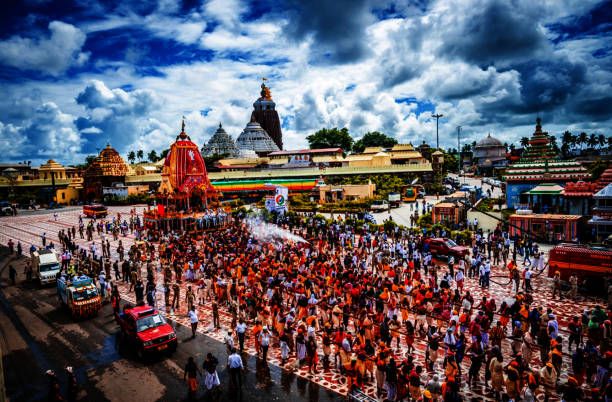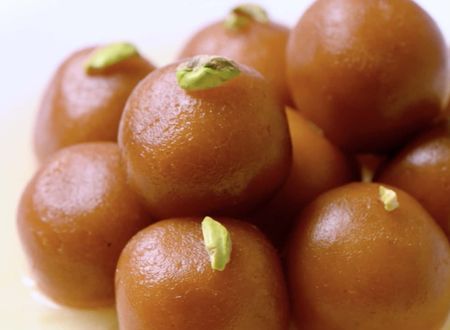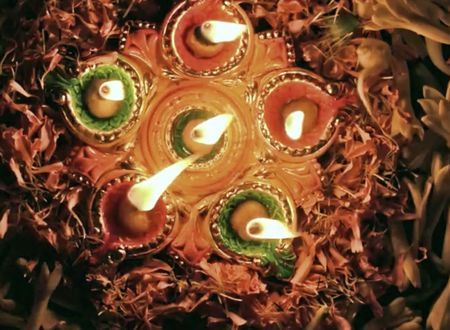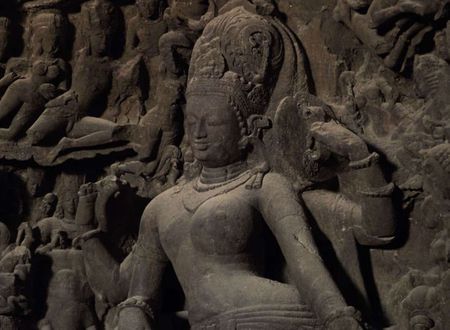In the previous posts (see Part-1 and Part-2), we discussed how the worship in the Puri Temple began and how the Ratha Yatra Utsab is organised every year. In this post we will go into the symbolism of Ratha Yatra, that is, what does Ratha Yatra want to convey?
If we speak of legends, Ratha Yatra symbolises the victory ride of Krishna and Balaram after Krishna killed Kansa in Mathura. But Puri’s Ratha Yatra is much more devotional in nature and is symbolic of the spiritual union between Radha and Krishna. We shall see how this is so.
Krishna left Vrindavan when he was 12 or so. After that, he never came back to Vrindavan. In the mode of separation from Krishna, all of Vrindavan was in transcendental agony. The trees withered in shoka; the cows mourned; Mother Yashoda kept preparing Krishna’s favourite dishes every day in the hope that one day he would come; Krishna’s playmates lost all their joy and so forth. They were so much in biraha that everywhere they used to see Krishna. And what to tell of Vraja-gopis…they were in the greatest bhav of Krishna. It was like their hearts were burning in fire, and still in greater pangs was Shrimati Radha Rani. So, all of Vrindavan grieved.
And Krishna also grieved for them. Here in Dwarka, despite being looked after by all his queens and having all the opulence of a princely kingdom, his heart was eternally residing in his beloved land of Vrindavan—in the forests, among his playmates, and in the love of Shri Radha. But he had missions to fulfil. He couldn’t just leave everything and go to Vrindavan. In fact, if he went, he would never come back again, because Vrindavan is his golok-dham. It is non-different from his celestial abode.
One day, in the palace room in Dwarka, Uddhav finds Krishna fainted on his bed. He fainted because he was in the transcendental mood of Radha Rani. He could no longer bear the separation. Uddhav stood there thinking how to wake him up. In the meantime, Devarshi Narada appeared. He saw Krishna’s condition. They started discussing how to revive him to his normal state. Narad Muni proposed that he would sing Radha Rani’s glories. Hearing this Krishna would wake up. Uddhav agreed. But there was one thing to be concerned about— after waking up, Krishna would want to rush to Vrindavan because he was currently in the mood of Gopinath, not Dwarkadhish, Uddhav feared. Narad also sensed the seriousness of the situation. Therefore he suggested to Uddhav that he should keep the chariot prepared before Krishna wakes up. When he would open his eyes, they would take him to the chariot. But Uddhav’s worries were not over…
If Krishna goes to Vrindavan, he might want to stay there forever and never come back. That would be terrible, Uddhav thought. This got them thinking. At this time, Balaram also joined. He saw the situation. Narad instructed Uddhav to go to Vrindavan to set the plot there, to pacify Vrindavanbasis so that they allow Krishna to come back. But Uddhav said, he can’t do that; that he had already been to Vrindavan on Krishna’s instructions; that he had tried to pacify the gopis but miserably failed. Their love for Krishna is so great that after meeting the gopis he also got completely drenched in ecstatic longing for Krishna. After that meeting, the only thing that Uddhav prayed for was that if he ever takes birth again, may he be born as the blades of grass on the holy land of Vrindavan, so that he gets the dust from gopis’ feet. This is famously known as the Uddhav-Gopi Samvad—how Uddhav’s superior knowledge was defeated before the intense love of gopis. So, Uddhav couldn’t go.
Narad then requested Balaram to go. But Balaram said nobody would listen to him. He had promised Vrindavanbasis he would bring Krishna and he had tried many times, but every time Krishna turned down his requests. And now they have lost faith in him. So, they would not listen to Balaram.
Now, Devi Subhadra came to their rescue. She said she would go; that she would be able to pacify Mata Yashoda, Nanda Baba and also the gopis because after all, she too has a woman’s heart. So, they would believe her. Thus it was decided that Subhadra Devi would go to Vrindavan first to make them ready for Krishna’s coming. Balaram said, “Well, I don’t have any problem going. I’ll go with you.” So, three chariots were prepared. Balaram left first. Subhadra’s chariot went second.
Once they left, Narad Muni started singing. After some time, Krishna slowly opened his eyes. But, as soon as he woke up, hearing the glories of Vrindavan and Radha Rani, he assumed the form of Banke Bihari—tri-bhang Murari—as if he’s playing his flute amongst the gopis in Vrindavan, just like olden days. He did not have the flute, nor the peacock feather. But, he thought he was in Vrindavan. Such was his mood that day.
Krishna saw both of them, and asked Uddhav, “Where am I, Uddhav? Am I in Vrindavan dreaming to be in Dwarka, or am I actually in Dwarka dreaming to be in Vrindavan?” “Lord, you are actually in Dwarka, in your palace”, replied Uddhav. He further said, “Hey Madhav, Daruk is waiting for you with the chariot to take you to Vrindavan.”
Krishna was in transcendental ecstasy. So much so that he was unable to walk properly. His head was swaying, and he was moving like he was drunk. Drunk on Radha’s love, so to speak. Narad and Uddhav held him by his sides and helped him sit in his chariot.
On the other side, in Vrindavan, when Balaram and Subhadra finally reached, they were stunned to witness the overwhelming mood of the gopis, especially that of Radha Rani. She laid on the ground and was surrounded by the ashta-sakhis. It seemed as if Radha was about to leave her body in the pain of separation from Krishna. One sakhi was applying chandan to cool down her body’s heat, another was chanting Krishna’s name. The whole of Vrindavan assembled there. Seeing such intense bhav, Balram and Subhadra’s bodies started to transform…their eyes got bigger…their hands went inwards…their hairs stood on end, their throats choked with emotion and their whole complexion changed.
They went there to pacify them. But even they were transfixed by the intense spiritual longing of the whole atmosphere.
Finally, Krishna came. As soon as he saw Radha Rani, he also transformed like Balaram and Subhadra. And that’s how the present form of Lord Jagannath, Lord Balaram, and Devi Subhadra came to be. It was a form taken in the mood of separation—biraha bhav. And thus, after a long time, Krishna and Vrindavan united again. Everybody worshipped Radha and Krishna. Their union symbolises the union of jivatma with paramatma, of a devotee with the Lord.
Radha Rani prayed to Krishna that may the whole world also get the taste of this divine longing that she had. Krishna granted her wish saying, “I’ll come in this form to give everyone this love.”
And that’s how the whole legend of Jagannath is thought of.
Now you know why Balaram’s chariot goes first, Subhadra’s second and Krishna’s at the end. Also, why Jagannath’s chariot moves like it’s swaying. Because that represents Krishna’s state. The pandas who take Jagannath to the chariot represent Narad and Uddhav. The Puri Temple symbolises Dwarka, and Gundicha Temple—Vrindavan. The Ratha Yatra therefore symbolises Krishna’s journey from Dwarka to Vrindavan. That’s why it is considered more sacred and of more merit if one does darshan of Lord in the Gundicha Temple, because for Krishna, it is Vrindavan. And Vrindavan is the place where he resides in his original form, with his eternal consort Shri Radha.
With this I end this series on Lord Jagannath.
Jai Jagannath!
—
Thank you for your attention.









Comments & Discussion
2 COMMENTS
Please login to read members' comments and participate in the discussion.